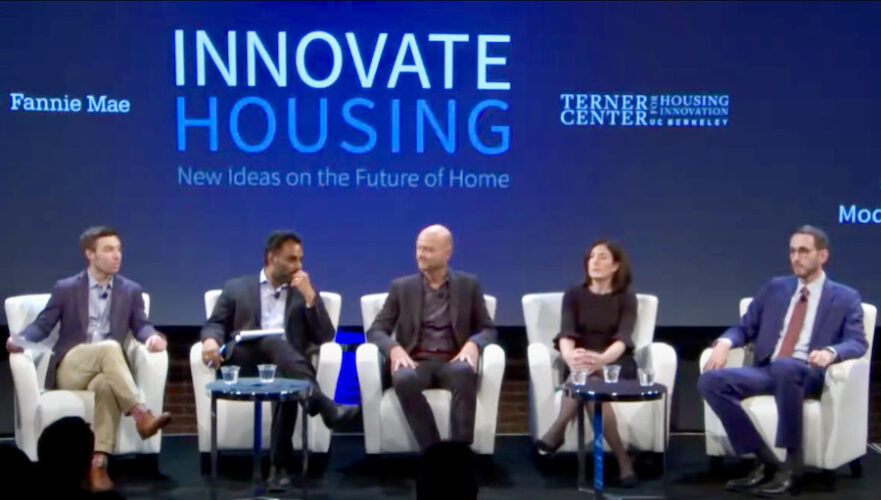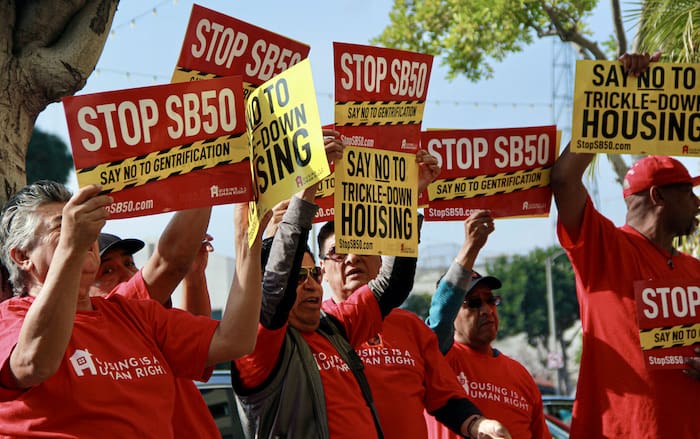
Through a weeks-long investigation, Housing Is A Human Right has found disturbing patterns in the housing coverage of Los Angeles Times reporter Liam Dillon. Most troubling, we discovered that Dillon repeatedly dismissed the housing justice movement in his work; routinely carried out biased coverage against AIDS Healthcare Foundation; and constantly promoted a “build, build, build” agenda, which matched up perfectly with the real estate industry’s political and financial agendas.
We also found that Dillon’s flawed, biased coverage was routinely executed by including certain facts, people, and groups in his stories while omitting other facts, people, and groups. What Dillon didn’t report was just as important as what he did report. It was a clever, subtle way to push an agenda without being too obvious, and readers with no knowledge or experience of housing and land-use issues had no idea what Dillon was doing.
The key findings of our 79-page report include:
- Dillon’s coverage routinely dismissed or downplayed the housing justice movement’s work, concerns, and perspective on various housing issues;
- He routinely handled AIDS Healthcare Foundation differently, and often unfairly, compared to the real estate industry, showing a bias against AHF;
- He routinely failed to give readers and voters important background information about AHF, misleading the public and harming people’s ability to make informed decisions about issues that involved AHF;
- He routinely failed to report the real estate industry’s role in fueling the housing affordability crisis;
- He routinely failed to report about the billions in revenue that were at stake for the real estate industry if a bill or ballot measure passed;
- He routinely failed to report the real estate industry’s profit motive to oppose or support a bill or ballot measure;
- He routinely promoted the real estate industry’s lucrative, self-serving “build, build, build” or “trickle-down housing” agenda as the key solution for the housing affordability crisis – an agenda that was also used as a political hammer against the housing justice movement to stop tenant protections, such as rent control;
- And Dillon should not have been covering various issues because of his constant participation as a moderator, speaker, or panelist at real estate industry events, which had compromised his integrity and impartiality as a reporter.
(Read Housing Is A Human Right’s findings report about Liam Dillon’s news coverage.)
The result of Dillon’s flawed, biased coverage was that the public was often misled or misinformed, preventing people from making informed decisions as voters and politically engaged residents. In addition, overcoming inaccurate and biased media coverage is especially difficult for housing justice activists, who are already battling the multi-trillion-dollar, multi-national real estate industry. It’s a David-and-Goliath struggle if there ever was one.
Dillon tries to present himself as an objective reporter. But the mountain of evidence we’ve collected – two special reports totaling 140 pages – shows he’s the opposite. Dillon is a journalist with an agenda, promoting the real estate industry’s “build, build, build” policies for years. It’s no wonder that real estate insiders kept inviting him back, year after year, to participate in their conferences, summits, and lobbying events.
(Dillon, pictured above to the far left, participates in a 2018 real estate industry event with California State Sen. Scott Wiener, above far right. More details below.)
AIDS Healthcare Foundation, based in Los Angeles, is the world’s largest HIV/AIDS medical-care nonprofit, operating in 45 countries and serving more than 1.7 million patients in countries such as South Africa, Mexico, India, and China. The organization was founded, in 1987, as a housing and medical-care provider for terminally ill HIV/AIDS patients in Los Angeles – a time when many people desperately needed safe, affordable housing in the final days of their lives.
Thirty years later, AHF saw firsthand that the worsening housing affordability and homelessness crises in California were negatively impacting its clients – the crises were also turning into dire public health emergencies. In response, in 2017, AHF decided to go back to its roots, establishing a housing provider division, Healthy Housing Foundation, and a housing advocacy division, Housing Is A Human Right. AHF’s longtime mission is to provide cutting-edge services and advocacy, regardless of one’s ability to pay.
Healthy Housing Foundation buys old hotels and motels in the L.A. area, quickly renovates them, and turns them into low-income and homeless housing. AHF and HHF have spent more than $183 million carrying out that adaptive reuse model, purchasing 14 buildings and creating nearly 1,700 apartments. It’s a wildly successful, urgent effort to save lives – since 2014, more than 7,300 unhoused residents have died on the streets in the L.A. area.
At the same time, Housing Is A Human Right advocates for the “3 Ps”: protect tenants through rent control and other tenant protections; preserve existing affordable housing, not demolish it to make way for luxury housing; and produce more new affordable housing. HHR also fights to stop the greed-driven policies of the real estate industry. In 2018 and 2020, HHR and AHF led the housing justice movement’s effort to change statewide rent control restrictions in California through two ballot measures.
Recently, Housing Is A Human Right looked into the work of L.A. Times reporter Liam Dillon, who sent out a misleading tweet thread about AIDS Healthcare Foundation earlier this year and has long covered the organization unfairly. In March, we published a special report about Dillon’s controversial participation in at least 20 real estate industry events between 2016 and 2023. His actions raised numerous conflict-of-interest issues, among other ethical issues. We concluded that Dillon’s integrity and impartiality as a reporter had been seriously compromised. And, by extension, the integrity and impartiality of his newspaper, the L.A. Times, had also been compromised.
 Dillon, far right in gray suit, participates as a moderator at a 2019 Urban Land Institute event — photo ULI’s Facebook page
Dillon, far right in gray suit, participates as a moderator at a 2019 Urban Land Institute event — photo ULI’s Facebook pageIt became clear that Dillon’s housing coverage also needed to be examined – and from the perspective of a housing justice activist. Housing Is A Human Right looked at his work for four major battles between the real estate industry and the housing justice movement, which includes Housing Is A Human Right and AIDS Healthcare Foundation. Those fights involve California State Sen. Scott Wiener’s land-use deregulation bills SB 827 and SB 50 and ballot measures Proposition 10 and Proposition 21, which aimed to end statewide rent control restrictions.
In total, Housing Is A Human Right analyzed 33 articles that Dillon wrote for the L.A. Times between 2017 and 2020. Again, we focused only on his coverage of SB 827, SB 50, Proposition 10, and Proposition 21. We attempted to find all of Dillon’s work on those bills and ballot measures, but in one instance a link didn’t work. Since we couldn’t find that story, it’s possible that others were missed, but it wasn’t for a lack of trying. We didn’t analyze Dillon’s brief articles that promoted his housing podcast and stories he co-wrote with another L.A. Times reporter.
(Read Housing Is A Human Right’s findings report about Liam Dillon’s news coverage.)
After spending weeks examining Dillon’s articles on SB 827, SB 50, Proposition 10, and Proposition 21, we believe, without any doubt, that we found valid, overall patterns of his work that are very troubling.
First of all, Dillon’s housing coverage largely revolves around one point: the real estate industry must be allowed to easily build as much housing as possible to solve California’s housing affordability crisis. For years, Dillon has constantly, and somewhat obsessively, made that point in his articles, as if he personally has something at stake.
Secondly, over the course of our investigation, it became clear that Dillon, who’s supposed to be an objective journalist, was writing with an agenda. And that agenda appears to be pushing forward his singular belief that the real estate industry must be allowed to build, build, build – no matter the consequences to others. Unsurprisingly, the real estate industry takes the same position.
Developers, lobbying groups, and other real estate insiders conveniently say that by flooding the rental housing market with new apartments, rent prices will drop for the poor and middle and working class. The real estate industry offers the “build, build, build” or “trickle-down housing” agenda as an alternative to tenant protections such as rent control. In fact, Big Real Estate uses the “build, build, build” agenda as a political hammer to stop rent control and other tenant protections, saying that any policy that harms housing production should not be passed – a USC study found that self-serving claim to be overblown.
In response, housing justice activists say that the “build, build, build” or “trickle-down housing” agenda does not guarantee that rent prices will drop; that developers build almost exclusively luxury housing; that the people who are getting hit hardest by the housing affordability crisis – the poor and middle- and working-class residents – need affordable housing, not luxury; that an influx of luxury housing in moderate- and lower-income neighborhoods will fuel gentrification and the displacement of longtime residents; and that “build, build, build” policies that focus on constructing luxury housing will enrich the real estate industry, but harm the poor and middle and working class. Instead, activists want housing policies that create more affordable housing – first and foremost.
In fact, many activists counter the “build, build, build” agenda with the “3 Ps”: protect tenants through rent control and other protections; preserve existing affordable housing, not demolish it to make way for luxury housing; and produce more affordable and homeless housing. The real estate industry, though, wants no part of that. Judging from his housing coverage, Dillon doesn’t appear to embrace the 3 Ps either.
Dillon and the real estate industry’s shared agenda to “build, build, build” is certainly one major reason why the L.A. Times reporter was continually invited to participate in at least 20 real estate industry or real estate industry-related events.
During the Proposition 10 campaign, for example, Dillon participated in the National Multifamily Housing Council’s 2018 Fall Meeting, a high-powered, lobbying event in Washington D.C. The NMHC and its sponsors were deeply involved in the No on Prop 10 campaign, and Dillon was covering that battle between the real estate industry and the housing justice movement for the L.A. Times. He should have steered clear of the NMHC event. Instead, he participated as a panelist, raising serious conflict-of-interest issues.
And leading up to the SB 50 battle that would play out in 2019 and 2020 between the real estate industry and the housing justice movement, Dillon participated as a moderator at a November 2018 conference hosted by the UC Berkeley Terner Center for Housing Innovation, a think tank that’s funded by Big Real Estate. The event was obviously a public showcase for State Sen. Scott Wiener to make a political argument for the passage of SB 50, a revised version of the land-use deregulation bill SB 827. Both bills were vigorously supported by the real estate industry, which had shelled out hundreds of campaign contributions to Wiener. The housing justice movement, including Housing Is A Human Right and AIDS Healthcare Foundation, largely opposed SB 50 and SB 827.
 Housing Is A Human Right protests SB 50
Housing Is A Human Right protests SB 50Dillon was covering SB 827 and SB 50 for the L.A. Times, and he should have steered clear from the Terner Center event. Instead, Dillon participated in it as a moderator of a panel that actually featured Scott Wiener – a high-profile politician that Dillon routinely covered for the L.A. Times. His impartiality and integrity as a reporter had again been compromised, especially since he was participating in the real estate industry’s effort to help Wiener pass SB 50. (See picture above.)
L.A. Times editors should not have allowed Dillon to continue to cover SB 50 – the same goes for Proposition 10 after he attended the National Multifamily Housing Council event. That didn’t happen. Dillon kept writing, and appeared to champion Wiener’s bill through his constant assertion, in the pages of the L.A. Times, that the real estate industry’s “build, build, build” agenda was the key solution for the housing affordability crisis. Housing justice activists argued that SB 50 and SB 827 would fuel gentrification and displacement and didn’t do enough to build more affordable housing for moderate- and low-income residents.
In his articles, Dillon wasn’t always overt in pushing his agenda. He often carried it out by including certain facts and people and groups in his stories while omitting other facts and people and groups. What Dillon didn’t report was just as important as what he did report. It was a clever, subtle way to push an agenda without being too obvious about it, and readers with no knowledge or experience of housing and land-use issues had no idea what Dillon was doing.
For SB 827, our investigation found that Dillon routinely dismissed or downplayed the housing justice movement’s work in opposing the bill; he failed to report the massive amounts of money at play for the real estate industry, which would make billions in revenue if the bill was passed; he failed to report the real estate industry’s role in fueling gentrification and the housing affordability crisis; he failed to report the real estate industry’s obvious profit motive to have the bill approved; he failed to report about the hundreds of campaign contributions from the real estate industry to State Sen. Scott Wiener; and he failed to write a much-needed profile on Wiener, a new state senator who was trying to pass highly controversial legislation that could impact millions of Californians.
Such an article would have examined Wiener’s past work as a San Francisco supervisor, his political allies, his political enemies, his campaign contributions, his working relationships with San Francisco housing justice groups, and other important facts the public needed to know. Dillon never wrote it.
Dillon and the L.A. Times, though, have written that kind of article, more than once, about AIDS Healthcare Foundation, showing a bias against AHF. Why? It may be that AHF and Housing Is A Human Right actively oppose, and fundamentally disagree with, the “build, build, build” agenda – and instead push for the “3 Ps” so moderate- and lower-income residents are rightly helped first.
In addition, during the SB 827 battle, we found that Dillon strangely never mentioned AIDS Healthcare Foundation and Housing Is A Human Right in his coverage, even though the organizations were leading opponents of the bill; he almost never mentioned the YIMBY movement’s aggressive support for SB 827, even though California YIMBY was a sponsor and helped draft the legislation; and Dillon regularly pushed Wiener and the real estate industry’s “build, build, build” political argument for addressing the housing affordability crisis.
To top it off, after largely failing to report about the YIMBY movement’s strong backing for SB 827 and mostly dismissing the housing justice movement, Dillon wrote an explainer piece about why the bill died. Incredibly, he cited the clash between YIMBYs and housing justice activists as “one of the primary reasons for the failure” of SB 827. Since he never reported about that battle in previous articles, it was a jarring u-turn by Dillon.
So jarring that it raises a number of questions. Did Dillon understand that the YIMBY movement was becoming a political liability for the effort to pass SB 827, so he decided to keep it out of his coverage in an effort to help the bill? Did Dillon understand that the housing justice movement’s opposition could be lethal for SB 827, and therefore he tried to prevent that death by largely dismissing housing justice activists?
That article, published in the L.A. Times on May 2, 2018, was titled “A major California housing bill failed after opposition from the low-income residents it aimed to help. Here’s how it went wrong.” That arrogant, dismissive headline was telling: by essentially calling low-income residents and activists’ concerns stupid, it perfectly reflected Dillon’s arrogant and dismissive approach towards the housing justice movement during the SB 827 battle.
With Dillon, one must always ask, why does he write about certain things? And why does he omit certain things? And what’s his agenda? It’s unfortunate that readers must be suspicious of Dillon, but the disturbing track record of his housing coverage and his constant participation in real estate industry events bring that suspicion upon himself – and the L.A. Times, for that matter.
For SB 50, we found that Dillon’s coverage didn’t improve – and he repeated many of the same failures that showed up in his coverage on SB 827, indicating a reporter who’s writing with an agenda.
He failed to report Wiener’s financial ties to the real estate industry; he failed to write a probing profile of Wiener; he failed to report that the California Association of Realtors, a powerful real estate lobbying group, and California YIMBY, which was founded and funded by Big Tech executives, were co-sponsors of SB 50; he routinely failed to report that SB 50 would create a financial windfall for the real estate industry; he routinely failed to report the real estate industry’s role in fueling gentrification and the housing affordability crisis; he routinely pushed the real estate industry’s “build, build, build” or “trickle-down housing” agenda; he failed to report the YIMBY movement’s aggressive support for SB 50; he routinely failed to report the real estate industry’s obvious profit motive to have the bill passed; he routinely dismissed or shortchanged the housing justice movement; and he never mentioned Housing Is A Human Right and AIDS Healthcare Foundation in his coverage, even though both organizations were among the most prominent opponents of SB 50.
For one article, titled “California could bring radical change to single-family home neighborhoods,” Dillon’s dismissal of activists and their movements was particularly glaring – and disturbing. In that piece, which was published in May 2019, he wrote a long passage about racist housing practices, essentially making the case that SB 50 would help cure that. Dillon – and any other reporter, for that matter – should have made a point to quote a housing justice or racial justice activist of color in that section. Predictably, that valuable, even necessary, quote was completely missing.
But Dillon did make a point of quoting Mott Smith, a developer and board member of the Council of Infill Builders – the real estate industry group was an official supporter of SB 50. Even more suspicious, only a few months after the publication of that piece, Dillon participated as a panelist at the Council of Infill Builders Annual Infill Conference at UCLA in July 2019 – and State Sen. Scott Wiener was the keynote speaker.
(Read Housing Is A Human Right’s findings report about Liam Dillon’s news coverage.)
Then we come to Proposition 10 and Proposition 21, which took place in 2018 and 2020, respectively. AIDS Healthcare Foundation and Housing Is A Human Right organized and largely funded the effort to first repeal statewide rent control restrictions (Prop 10) and then reform those restrictions (Prop 21). A broad coalition of hundreds of housing justice groups, social justice organizations, labor unions, and civic leaders strongly backed the Yes on Prop 10 and Yes on Prop 21 campaigns.
 Dillon, third from left, participates in a 2016 California Apartment Association forum — photo from CAA Facebook page.
Dillon, third from left, participates in a 2016 California Apartment Association forum — photo from CAA Facebook page.Dillon covered both initiatives for the L.A. Times, and his reporting repeatedly failed to mention or provide specifics about the coalition that supported Prop 10 and Prop 21, misleading voters into thinking that only AIDS Healthcare Foundation was trying to change statewide rent control restrictions. That failure also essentially dismissed the housing justice movement’s work on Prop 10 and Prop 21. And again, that kind of repeated failure indicates a reporter who’s writing with an agenda.
In addition, Dillon repeatedly failed to provide important background information about AIDS Healthcare Foundation’s life-saving HIV/AIDS medical work around the globe and its housing provider division, Healthy Housing Foundation, and its housing advocacy division, Housing Is A Human Right. It’s vital information that voters need to make an educated decision at the ballot box. Dillon provided none of it.
Why? We know that Dillon constantly champions the real estate industry’s “build, build, build” agenda in his articles, and the reporter has made it clear at more than one real estate industry appearance that he personally believes the mass construction of market-rate housing is key for solving the housing affordability crisis. We also know that the real estate industry uses the “build, build, build” agenda as a political hammer to stop rent control, saying it will harm housing production and therefore worsen the housing affordability crisis. Did Dillon also believe that rent control was bad for housing production, and therefore carried out biased and incomplete coverage against AHF and its ballot measures?
Dillon’s bias appeared in other ways. For both Prop 10 and Prop 21, he routinely made a point of reporting exactly how much money AHF had contributed to the Yes on Prop 10 and Yes on Prop 21 campaigns. Just as routinely, he almost never provided specifics about the real estate industry’s campaign contributions to the No on Prop 10 and No on Prop 21 campaigns. And Dillon almost never reported that the California Apartment Association, one of the most powerful and politically connected real estate lobbying groups in the state, was leading the No on Prop 10 and No on Prop 21 campaigns.
When one reads through Dillon’s Prop 10 and Prop 21 coverage, it’s more than obvious that the L.A. Times reporter handled AHF very differently compared to the real estate industry, and often unfairly, showing a clear pattern of bias against the nonprofit.
And similar to SB 827 and SB 50, Dillon repeatedly refused to report about the real estate industry’s obvious profit motive to kill the ballot measures – except for one article out of more than a dozen stories he wrote about Prop 10 and Prop 21. He also routinely failed to report about the real estate industry’s role in fueling the housing affordability crisis by carrying out predatory business practices.
At the same time, Dillon continually reported the real estate industry’s “build, build, build” political argument against Prop 10 and Prop 21.
If anything, Dillon had been consistent in his flawed, biased, incomplete coverage of Prop 10, Prop 21, and AHF – again, another indication of a reporter pushing an agenda.
Housing Is A Human Right’s special reports on Dillon’s participation in real estate industry events and his news coverage of SB 827, SB 50, Prop 10, and Prop 21 show that his impartiality and integrity as a reporter has been compromised – and must be seriously questioned. In fact, there’s a strong case to be made that Dillon should not have been covering those four major battles after he participated in numerous real estate industry or real estate industry-related events.
Our reports also show that Dillon may be pushing his own “build, build, build” agenda through the pages of the L.A. Times. Perhaps his editors are fine with that. But he cannot try to fool the public into thinking he’s an objective reporter. The mountain of evidence we’ve collected, totaling 140 pages, shows he’s quite the opposite: he’s a journalist promoting an agenda that matches up perfectly with the political and financial agendas of the real estate industry. It’s no wonder that real estate insiders kept inviting him back, year after year, to participate in their conferences, summits, and lobbying events.
(Read Housing Is A Human Right’s findings report about Liam Dillon’s news coverage.)

